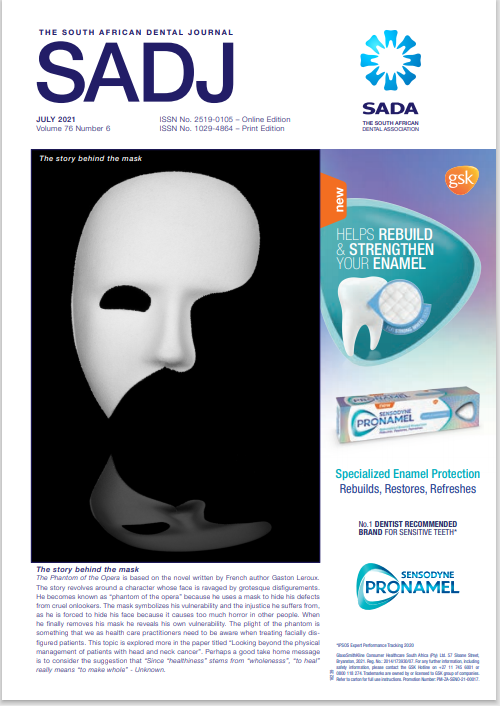Correctional repositioning of pathologically migrated maxillary premolars through periodontal therapy
Keywords:
Periodontitis, bicuspids, pathologic tooth migration, root Planing, spontaneous reposition.Abstract
Pathological tooth migration (PTM) is the displacement of teeth as a balance among forces that maintain the position are disrupted. It is a common occurrence in a patient suffering from periodontitis. Its treatment includes periodontal therapy followed by a complex interdisciplinary approach to rectify the tooth position. However, it has also been observed that in certain cases periodontal therapy alone can cause a corrective repositioning of the teeth leading to a closure or a reduction in the displacement. Present case report depicts a nineteen-year-old, healthy nonsmoker male patient with generalized Stage IV Grade C periodontitis. Deep periodontal pockets in #24 and #25 were observed along with a pathological migration of 1.6mm. The patient underwent conventional periodontal
surgical intervention. It was noted that the therapy resulted in a reduction of the gap from 1.6 to 0.2mm and distal migration of #24 and a bucco-mesial migration of #25 in the course of one year of follow up. Thus, an early diagnosis and treatment of PTM through
the restoration of periodontal health at the right time can cause a corrective repositioning of the teeth in a predictable direction.
Downloads
References
Petersen PE and Ogawa H. The global burden of periodontal disease: towards integration with chronic disease prevention and control. Periodontol. 2000. 2012; 60: 15-39
Kassebaum NJ, Bernabé E, Dahiya M, Bhandari B, Murray CJ, Marcenes W. Global burden of severe periodontitis in 1990- 2010: a systematic review and meta-regression. J Dent Res. 2014; 93: 1045-53.
Carranza FA. Periodontal response to external forces. In: Newman MG, Takei HH, Klokkevold PR, Carranza FA Editors. Carranza’s Clinical Periodontolgy. 11th Ed. Elsevier Saunders. 2012; 197-206.
Proffit WR. Equilibrium theory revisited: factors influencing position of the teeth. Angle Orthod.1978; 48: 175-86.
Martinez-Canut P, Carrasquer A, Magán R, Lorca A. A study on factors associated with pathologic tooth migration. J Clin Periodontol. 1997; 24: 492-97.
Towfighi PP, Brunsvold MA, Storey AT, Arnold RM, Willman DE, McMahan CA. Pathologic migration of anterior teeth in patients with moderate to severe periodontitis. J Periodontol. 1997; 68: 967-72.
Rohatgi S, Narula SC, Sharma RK, Tewari S, Bansal P. Clinical evaluation of correction of pathologic migration with periodontal therapy. Quintessence Int. 2011; 1: 42.
Rohatgi S, Narula SC, Sharma RK, Tewari S, Bansal P. A study on clinical attachment loss and gingival inflammation as etiologic factors in pathologic tooth migration. Niger J Clin Pract. 2011; 14: 449-53
Weinstein S, Haack DC, Morris LY, Snyder BB, Attaway HE. On an equilibrium theory of tooth position. Angle Orthod.
; 33:1-26. 10. 10. Gaumet PE, Brunsvold MI, McMahan CA. Spontaneous repositioning of pathologically migrated teeth. J Periodontol. 1999; 70:1177-84.
Hirschfeld I. The dynamic relationship between pathologically migrating teeth and inflammatory tissue in periodontal pockets: A clinical study. J Periodontol. 1933; 4: 35-47.
Downloads
Published
Issue
Section
License
Copyright (c) 2021 Sumidha Bansal, Chandrababu S Baiju, Karuna Joshi

This work is licensed under a Creative Commons Attribution-NonCommercial 4.0 International License.





.png)